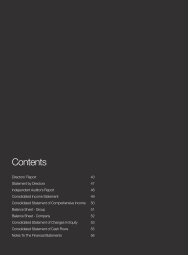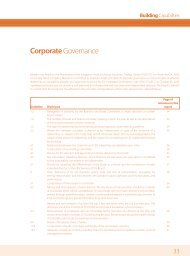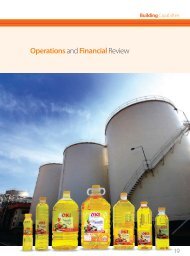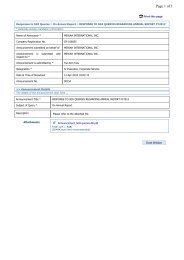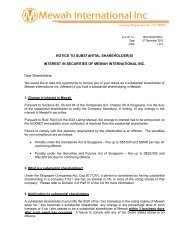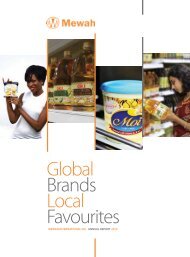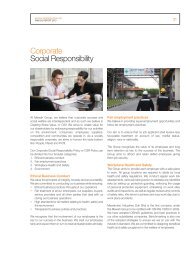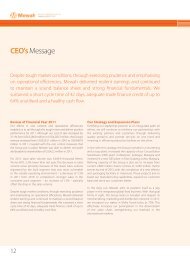Financial Statements - Mewah Group
Financial Statements - Mewah Group
Financial Statements - Mewah Group
Create successful ePaper yourself
Turn your PDF publications into a flip-book with our unique Google optimized e-Paper software.
Building Capabilities<br />
Notes to the <strong>Financial</strong> <strong>Statements</strong><br />
For the financial year ended 31 December 2011<br />
32. <strong>Financial</strong> risk management (continued)<br />
(a)<br />
Market risk (continued)<br />
(ii)<br />
Cash flows and fair value interest rate risks (continued)<br />
The <strong>Group</strong>’s policy is to enter into variable interest rates borrowings. As most of the <strong>Group</strong>’s borrowings are shortterm<br />
and trade related, accordingly, the <strong>Group</strong> has minimum cash flows interest rate exposure risk.<br />
The <strong>Group</strong>’s borrowings were denominated mainly in Ringgit and USD. As at 31 December 2011, profit after tax for<br />
the financial year would have been US$174,000 (2010: US$79,000) lower or higher if market interest rates had been<br />
50 basis points higher or lower with all other variables held constant.<br />
(iii)<br />
Commodity price risk<br />
The <strong>Group</strong> is exposed to fluctuations in the prices of agri-commodities it deals in, including crude palm oil and<br />
palm oil products prices. The <strong>Group</strong> minimises the risk arising from such fluctuations by entering into commodities<br />
forward contracts and futures contracts. The <strong>Group</strong> has not adopted hedge accounting.<br />
In the course of entering into these contracts, the <strong>Group</strong> may be exposed to the inherent risk associated with<br />
trading activities conducted by its personnel. The <strong>Group</strong> has in place a risk management system to manage such<br />
risk exposure.<br />
As at 31 December 2011, if the commodity prices increase or decrease by 5% and other variables held constant, the<br />
<strong>Group</strong>’s profit after tax would have been US$6,457,000 (2010: US$6,305,000) lower or higher respectively, arising as a<br />
result of the change in fair value of the commodities forward and futures contracts.<br />
(b)<br />
Credit risk<br />
Credit risk refers to the risk that counterparty will default on its contractual obligations resulting in financial loss to the<br />
<strong>Group</strong>. The major classes of financial assets of the <strong>Group</strong> are trade and other receivables and bank deposits. For trade and<br />
other receivables, the <strong>Group</strong> adopts the policy of dealing only with customers of appropriate credit history, and obtaining<br />
sufficient collateral or buying credit insurance where appropriate to mitigate credit risk. For other financial assets, the<br />
<strong>Group</strong> adopts the policy of dealing only with high credit quality counterparties.<br />
107



